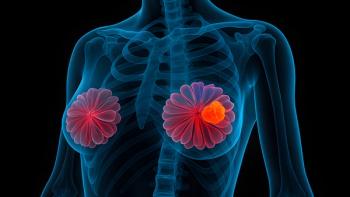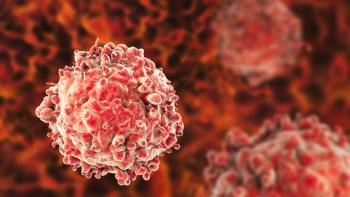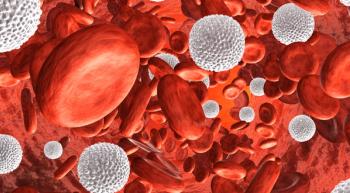
Dermatologic Protocol Preserves QOL in EGFR+ Advanced NSCLC Treatment
COCOON skin care led to fewer or milder dermatologic symptoms with amivantamab/lazertinib vs standard care in patients with EGFR+ advanced NSCLC.
Patients with EGFR-mutant non–small cell lung cancer (NSCLC) who received the COCOON dermatologic management protocol experienced better quality of life (QOL) and fewer skin-related adverse effects (AEs) with amivantamab-vmjw (Rybrevant) plus lazertinib (Lazcluze) compared with those who received standard skin care, according to phase 2 COCOON trial data (NCT06120140) presented at the
A lower average Skindex-16 total score was reported in patients who received COCOON DM vs those with SOC DM at day 15 of cycle 3 (P = .023). Additionally, use of COCOON DM correlated with improvements in the functioning (P = .037), emotional (P = .046), and symptoms subscales (P = .011).
No moderate or severe symptoms on the Patient Global Impression of Severity (PGI-S) scale occurred among patients who received COCOON DM at day 15 of cycle 3. The rates of patients reporting no symptoms in the COCOON DM and SOC DM arms, respectively, were 21% vs 7% for rash (P = .061), 23% vs 7% for skin conditions (P = .194), and 27% vs 16% for nail infections (P = .270).
“At this analysis, which evaluated the first 12 weeks of treatment, [patients] in the COCOON DM arm experienced lower severity of dermatologic symptoms and a reduced impact on QOL than [patients] in the SOC DM arm,” lead study author Jill Feldman, founder of EGFR Registers, a patient advocacy group in Deerfield, Illinois, wrote with coauthors.1 “Substantial and consistent separation favoring COCCON DM was observed in all postbaseline Skindex-16 subscales. Most [patients] in the COCOON DM arm reported mild or no dermatologic symptoms. This benefit was consistently observed across the first [approximately] 10 weeks of treatment.”
Investigators of the phase 2 COCOON trial prospectively assessed a novel DM regimen for preventing moderate to severe EGFR-associated AEs that may occur following treatment with amivantamab plus lazertinib. In this analysis, investigators highlighted patient-reported outcomes from the first 12 weeks of therapy.
A total of 201 patients were randomly assigned to receive amivantamab/lazertinib plus COCOON DM (n = 99) or SOC DM (n = 102). The COCOON regimen consisted of oral doxycycline or minocycline for 12 weeks followed by topical clindamycin lotion each day on the scalp, starting at week 13 for 9 months; chlorhexidine on the nails each day for 12 months; and ceramide-based moisturizer applied to the body and face at least each day for 12 months. In the SOC DM arm, patients received general skin prophylaxis based on local practice and relative treatment, including corticosteroids and systemic antibiotics.
The study’s primary end point was the incidence of grade 2 or higher dermatologic AEs within the first 12 weeks following the beginning of amivantamab/lazertinib therapy. The select secondary end points were PROs per Skindex-16 and PGI-S after 12 weeks of follow-up.
The Skindex-16 questionnaire was validated to determine how skin conditions impact QOL based on the subscales of functioning, emotional, and symptoms. The PGI-S was a patient-reported 4-point rating scale—none, mild, moderate, or severe symptoms—used to evaluate the severity of rashes, skin conditions, and nail infections over time.
Those with locally advanced or metastatic, treatment-naive NSCLC harboring documented EGFR exon 19 deletions or L858R mutations were eligible for enrollment on the study. An ECOG performance status of 0 or 1 was an additional requirement for study entry.
The investigators noted that the FDA approved
References
- Feldman J, Cho BC, Li W, et al. Dermatologic prophylaxis and impact on patient-reported outcomes in first-line EGFR-mutant advanced NSCLC treated with amivantamab plus lazertinib: results from the phase 2 COCOON trial. J Clin Oncol. 2025;43(suppl 16):8641. doi:10.1200/JCO.2025.43.16_suppl.8641
- RYBREVANT (amivantamab-vmjw) plus LAZCLUZE (lazertinib) approved in the U.S. as a first-line chemotherapy-free treatment for patients with EGFR-mutated advanced lung cancer. News release. Johnson & Johnson. August 20, 2024. Accessed May 31, 2025. https://tinyurl.com/yxc8u8t4
Newsletter
Knowledge is power. Don’t miss the most recent breakthroughs in cancer care.
















































































